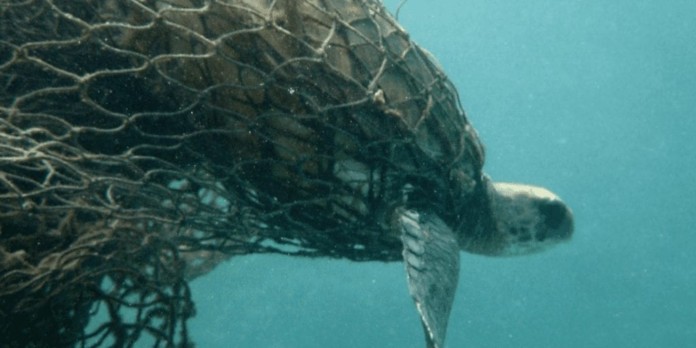Urgent research in biodegradable fishing nets and strict enforcement of producer responsibility on nylon nets can reduce ocean pollution
“When it comes to marine life, our existence depends upon their existence.” -June Stoyer, environmental advocate.
More than 3 billion people depend on oceans for their livelihood. Additionally, marine ecosystem services have more than 60 % economic value of all life on earth. Despite these astounding numbers and our dependence on the ocean, the marine ecosystem’s health is often neglected. Prevention of marine pollution is given low priority by most national governments, resulting in an unprecedented increase in marine pollution.
The fundamental cause of marine pollution is the dumping of plastics in the ocean. Continuous accumulation of plastic in the marine ecosystem has disturbed the lifecycle of marine organisms. Developing countries like China, Indonesia, India are major sources of plastic pollution. The Indian government has taken many measures to prevent plastic pollution, including banning single-use plastics. Despite such progressive laws, the enormity of the plastic pollution problem is so high that the enactment of laws did not cause a significant impact on plastic discharge into oceans. Hence, there is a need for a more targeted approach from governments that will involve businesses and plastic manufacturers to,
One of the most significant sources of plastic pollution is the fishing nets discarded by fishermen in oceans. Nearly 50% of the ocean plastic is fishing nets. These fishing nets stay in the ocean for a long time and inadvertently trap fishes, turtles, dolphins, and other marine fauna leading to ghost fishing. These ghost nets are made of nylon plastics and hence have a very long shelf life. Moreover, even in later stages, they decompose into microplastics and enter the marine organisms’ food web
After fishing gear has deteriorated to such an extent that it cannot be reused, it can be recycled. However, it is rather disposed of in the ocean than recycled as there is not sufficient incentive to bring the nets back to the shore. This issue can be solved if government and businesses work together and create a pull factor to recycle the fishing nets. The government should take a comprehensive survey of the fishing gear manufacturers (both formal and informal) to understand the profitability, operating margins, and financial health of players in this ecosystem. Every commercial fishing gear unit should be given a unique id, and the producers should be held responsible for recycling them. Such an Extended Producer Responsibility (EPR) can be enforced if each of the nets has a small GPS device that tracks the fishing gear’s location. The government can provide GPS equipment at a subsidized cost to keep the fishing gear affordable. A fine can be levied on the fishing gear manufacturers if they do not recycle pre-set percentage (say 75%) of the manufactured fishing nets.
Another practice that helps in reducing the issue of ghost nets is using biodegradable fishing nets. Presently, the performance of biodegradable fishing nets is not on par with nylon nets. Therefore, there is a requirement for a government push to encourage the usage of biodegradable nets. This nudge can be either in the form of higher taxes on nylon tax manufacturing or tax sops on biodegradable net manufacturing. A long-term solution would be to promote material research in premier institutes like IITs, NITs to improve biodegradable nets’ performance.
Moreover, large businesses can be encouraged to recycle plastic as part of their CSR activities. As ensuring environmental sustainability comes under CSR’s ambit, big companies can be encouraged to partner with fishing gear manufacturers to ensure that fishing nets are recyclable. Even production or distribution of biodegradable fishing nets can be part of companies’ CSR.
Materializing these measures needs a significant commitment from the government. The Indian government has shown through its Extended Producers Responsibility Framework by the Union environment ministry that it is serious about tackling plastic pollution. If the government shows a similar commitment to tackle abandoned ocean fishing nets, it can significantly improve the marine ecosystem.
While these steps might help prevent marine pollution to some extent, reaching the ambitious goal of zero plastic waste by 2030 requires much more comprehensive strategies. It requires transformational change in society so that every person on the planet says no to plastic in any form. Only when business, government, and society work in tandem towards eliminating plastic can we truly make this planet sustainable.
References
https://www.lifegate.com/biodegradable-nets-tackling-ghost-fishing












[…] How to Prevent Fishing Net Pollution […]